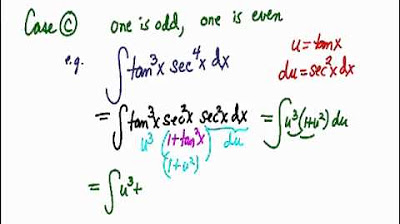Intégrales - partie 1 : l'intégrale de Riemann
Summary
TLDRThis chapter segment delves into the concept of integrals, specifically the Riemann integral, starting with simple step functions to build up to more complex function integration. It introduces the integral of an exponential function and demonstrates the process of approximating areas under the curve using rectangles. The main theorem is that continuous functions are integrable, and a proof is provided. The lesson also covers basic properties of integrals and explains how to define the integral for any given function, including those not integrable, such as the Dirichlet function. The importance of understanding the integral's definition for both bounded and unbounded functions is highlighted, concluding with the integral calculation for a quadratic function and the proof that continuous functions are integrable.
Takeaways
- 🔢 The chapter introduces Riemann integration, starting with simple step functions to define integrals.
- 📐 The integral of the exponential function is used as an example to calculate the area under a curve between x=0 and x=1.
- 🟩 By subdividing the interval and using lower and upper rectangles, the area under the curve is approximated.
- ↔️ As the number of subdivisions increases, the area approximation converges to the true integral.
- 🧮 The integral of a step function is defined as the sum of areas of rectangles formed under the function.
- ✅ A function is integrable if the limit of the areas under and above it are equal as subdivisions become finer.
- ⚠️ Not all functions are integrable; however, continuous functions are always integrable.
- 🚧 A non-integrable function example is given, where the function takes different values based on whether x is rational or irrational.
- 🔍 The integral of a general bounded function is defined using the upper and lower step functions.
- 📊 Continuous functions can be closely approximated by step functions, leading to their integrability.
Q & A
What is the primary focus of the first part of the chapter on integrals?
-The primary focus is on understanding the definition of the integral, particularly the Riemann integral, rather than on performing calculations.
How is the Riemann integral initially defined for simple functions?
-The Riemann integral is initially defined for simple step functions, which are functions that are constant on subintervals of a given interval.
What is the significance of step functions in defining the Riemann integral for more general functions?
-Step functions are used as a foundational tool to define the Riemann integral for more general functions, allowing for the development of the concept by approximating the area under a curve.
What is the main theorem introduced in this chapter regarding continuous functions?
-The main theorem states that continuous functions admit integrals, and the proof of this theorem is provided in the chapter.
How are the areas under the curve of the exponential function approximated?
-The areas are approximated using sums of areas of rectangles positioned under and above the curve, with the sum of the lower rectangles converging to the integral as the number of subdivisions increases.
What happens to the sums of the areas of the lower and upper rectangles as the number of subdivisions increases?
-As the number of subdivisions increases, the sums of the areas of the lower and upper rectangles both converge to the same value, which represents the integral of the function.
How is the integral defined for a general bounded function?
-The integral for a general bounded function is defined using the concept of step functions that approximate the function from below and above. The integral exists if the upper and lower sums converge to the same value.
What conditions must a function meet to be integrable according to the Riemann definition?
-A function is Riemann integrable if the upper sum and lower sum for step functions converge to the same value, meaning that the area under the curve can be accurately approximated from both sides.
Can you give an example of a function that is not Riemann integrable?
-Yes, a function that takes the value 1 at rational points and 0 at irrational points on an interval is not Riemann integrable because the upper and lower sums do not converge to the same value.
What is the result of integrating the function f(x) = x^2 over the interval [0, 1]?
-The integral of f(x) = x^2 over the interval [0, 1] is equal to one-third, as calculated using the definition of the Riemann integral and the approximation with step functions.
Outlines

This section is available to paid users only. Please upgrade to access this part.
Upgrade NowMindmap

This section is available to paid users only. Please upgrade to access this part.
Upgrade NowKeywords

This section is available to paid users only. Please upgrade to access this part.
Upgrade NowHighlights

This section is available to paid users only. Please upgrade to access this part.
Upgrade NowTranscripts

This section is available to paid users only. Please upgrade to access this part.
Upgrade Now5.0 / 5 (0 votes)





